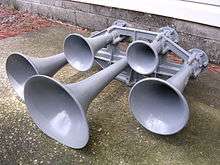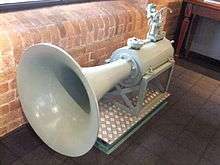Air horn
An air horn is a pneumatic device designed to create an extremely loud noise for signalling purposes. It usually consists of a source which produces compressed air, which passes into a horn through a reed or diaphragm. The stream of air causes the reed or diaphragm to vibrate, creating sound waves, and the horn amplifies the sound so it is louder. Air horns are widely employed as vehicle horns, installed on large semi-trailer trucks, fire trucks, trains, and some ambulances as a warning device, and on ships as a signalling device.
How it works
An air horn consists of a flaring metal or plastic horn or trumpet (called the "bell") attached to a small air chamber containing a metal reed or diaphragm in the throat of the horn. Compressed air flows from an inlet line through a narrow opening past the reed or diaphragm, causing it to vibrate, which creates sound waves. The flaring horn serves as an acoustic "transformer" to improve the transfer of sound energy from the diaphragm to the open air, making the sound louder. In most horns it also determines the pitch of the sound. When vibrated by the diaphragm, the column of air in the horn vibrates in standing waves. The length of the horn determines the wavelength of the sound waves generated, and thus the fundamental frequency (pitch) of the note produced by the horn. The longer the horn, the lower the pitch.
Larger air horns used on ships and foghorns function similarly to a whistle; instead of a diaphragm the air escapes from a closed cylindrical resonator chamber through a precisely shaped slit directed against a knife edge (fipple). The air blowing past the knife edge oscillates, creating sound waves. The oscillations excite standing waves in the resonator chamber, so the length of the chamber determines the pitch of the note produced.
Trucks
In trucks, the air horn is powered with compressed air from the vehicle's air brake system. A cord mounted on the ceiling of the operator's cab is pulled to open the valve, supplying varying amounts of air to the horn. Thus, an outstretched hand reaching upward and pumping is a signal to the driver of an air horn equipped vehicle, requesting a toot. In modern trucks the horn is actuated by a button on the steering wheel (just like a normal car horn). Some trucks have both electric and air horn, selectable by a switch on the dashboard. This is to prevent the use of the powerful air horn in populated areas.
Emergency vehicles
Many fire trucks, ambulances, and other large emergency vehicles operate air horns as a means of warning vehicles to clear the right-of-way.
There are also electronic horns for emergency vehicles, which produce a similar easily recognizable sound. These are typically integrated into the same system as the vehicle's electronic siren, and sound through the same speakers. In the last several decades, electronic sound systems with more widely varying frequencies have been chosen as common supplemental warning systems.
Locomotives

Originally, diesel locomotives were equipped with truck horns. After an accident in which a driver mistook a train for a truck, the need for a unique-sounding train horn became clear.[1] Consequently, North American trains now have at least two horns with different tones forming the airhorn, that sound simultaneously, creating a harmonic interval or chord. Each individual horn is called a "chime". Three and five-chime configurations are the most common, but two chime horns also exist.[2]
Fifteen to twenty seconds before entering a grade crossing, federal law requires locomotives to sound their horns in a standard warning sequence. This succession consists of two long, one short, and one long horn sounding repeated as necessary until the locomotive clears the crossing. Exceptions to federal law occur in locations with established quiet zone ordinances that prohibit sounding locomotive horns.
In recent years, it has become a fad for car and truck enthusiasts to install large air horns on their vehicles.[3] Some jurisdictions do not allow an airhorn to be attached, whether or not it can be activated.
Portable or personal air horns
Portable air horns are also readily available packaged with a can of compressed air as the air source. These are often sounded by fans at sporting events such as American football, basketball, hockey and association football, and at other events such as graduations. Small versions are sometimes used as bicycle horns or non-lethal weapons for self-defense, mainly as an auditory distraction to get away from an attacker. At close range, they can also be used as freeze sprays (when the container is held upside-down). The reason an air horn can function as an effective refrigerant is that the gases contained within the device are highly pressurized, which means that the object also acts as a pressure vessel. Additionally, air horns (especially those that contain fluorocarbons) have the potential to be used as recreational drugs since many such refrigerants can be inhaled for a quick and dangerous intoxication.[4]

Use in sports
The air horn is used for signalling in various sports:
- in ice hockey (especially in the NHL)
- in the NLL
- Major League Baseball
- indoor soccer
NHL arenas normally employ two horns — a high pitch horn that announces the end of the period, and a much louder, lower pitch horn that is sounded when the home team scores and/or wins a game. Some MLB stadiums use horns for similar purposes, such as when a member of the home team hits a home run. In many places, air horns are used for signaling the end of the period or quarter on scoreboard systems.
In mixed martial arts, an air horn is commonly used to signal the end of a round as opposed to the bell used in boxing and professional wrestling. For outdoor activities like hiking, hunting, cross-country skiing, canoeing, fishing, an air horn can be handy to frighten away unwanted or aggressive wildlife, signalling for help and to announce one's location. Bicyclists occasionally use this type of horn, since it yields a louder warning sound than traditional bicycle bells or bulb reed horns.
Popular culture
Air horns have been used as jokes, and running gags in cartoons and movies. In the Jackass television series and movies, air horns are occasionally used to frighten people.
A popular Web series called "Terror On The Streets" depicts drivers of such vehicles startling unsuspecting pedestrians while driving through urban areas.[5] Practitioners amuse themselves by driving around blasting air horns at others, or using them in other ways. YouTube has many videos about such events. A common undertaking with the air horn is the accordingly-named "golf course air horn", where pranksters blow a horn just as an unsuspecting golfer is coming down with their swing. As an air horn is very loud (120+ dB), any of these activities should always be done with a sufficient distance to the victim, as permanent noise-induced hearing loss may otherwise result.
The air horn is also a popular sample in reggae music. Jamaican dancehall music was the first musical genre to use the effect, and has been using the airhorn sample for over 26 years, in live shows as well as on mixtape recordings, and in Puerto Rican reggaeton, a reggae hybrid genre since the late 80s and 90s. [6] The sound effect has recently been used in hip hop music as well.
Samples of various air horns have been used by NHL teams when the home team scores a goal, often accompanied by music.
Air horn sound effects are regularly featured in the videos of political satirist Vic Berger on the Super Deluxe channel and are typically used by one or more fictional Donald Trump-supporting audience members in celebration of Mr. Trump’s verbal attacks, or to interrupt other candidates as they speak.[7][8]
The "Air Horn Orchestra" gathered weekly every Wednesday from April 13, 2016 until the November 2, 2016 at the North Carolina Governor's Mansion to protest HB2 and Governor Pat McCrory by making a racket.[9][10][11][12] The 30th and final performance is expected to set the Guinness World Record for the number of simultaneously sounding air horns, having had 342 participants. This was the last performance owing to the gubernatorial election 6 days later.[13]
See also
References
| Wikimedia Commons has media related to Air horns. |
- ↑ "Archived copy". Archived from the original on February 13, 2009. Retrieved January 9, 2006.
- ↑ "A Collection of Airhorns". Horns Inc. Retrieved 2015-08-02.
- ↑ "WESH.com New Horns Make Cars Sound Like Trains". Retrieved 2008-05-20.
- ↑ Harris, Catharine. "Anti-inhalant Abuse Campaign Targets Building Codes: ‘Huffing’ of Air Conditioning Refrigerant a Dangerous Risk." The Nation's Health. American Public Health Association, 2010. Web. 05 Dec. 2010. <http://thenationshealth.aphapublications.org/content/39/4/20.extract>.
- ↑ https://www.youtube.com/results?search_query=terror+on+the+streets
- ↑ http://www.redbullmusicacademy.com/magazine/in-search-of-the-air-horn
- ↑ Chen, Adrian (7 April 2016). "A Political Satirist for the Internet Election". The New Yorker. Retrieved 10 June 2016.
- ↑ Collins, Sean. "Vic Berger IV Is Vine's Strangest Political Satirist | VICE | United States". VICE. Retrieved 10 June 2016.
- ↑ Campbell, Colin (April 13, 2016). "'Air horn orchestra' seeks McCrory's attention on House Bill 2". News & Observer. Retrieved April 24, 2016.
- ↑ Brown, Joel (April 20, 2016). ""Air Horn Orchestra" Blasts HB2 Disapproval in Raleigh". WTVD/ABC-11. Retrieved April 24, 2016.
- ↑ Brown, Joel (June 1, 2016). "McCrory, Cooper Spar Over HB2; Noisy Protests Continue". WTVD. Retrieved June 1, 2016.
- ↑ Brown, Joel. "'Air Horn' Protesters Call Foul on HB2 After ACC's Action". Retrieved September 15, 2016.
- ↑ Brown, Joel (November 2, 2016). "Final "Air Horn" Protest May Have Set a World Record Outside Executive Mansion". WTVD/ABC11. Retrieved November 2, 2016.